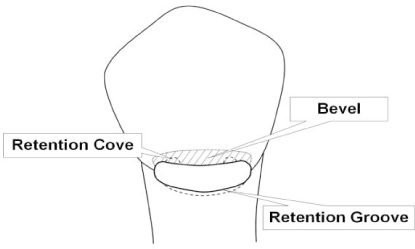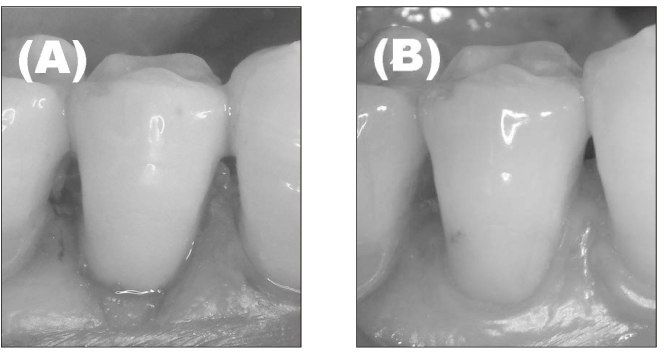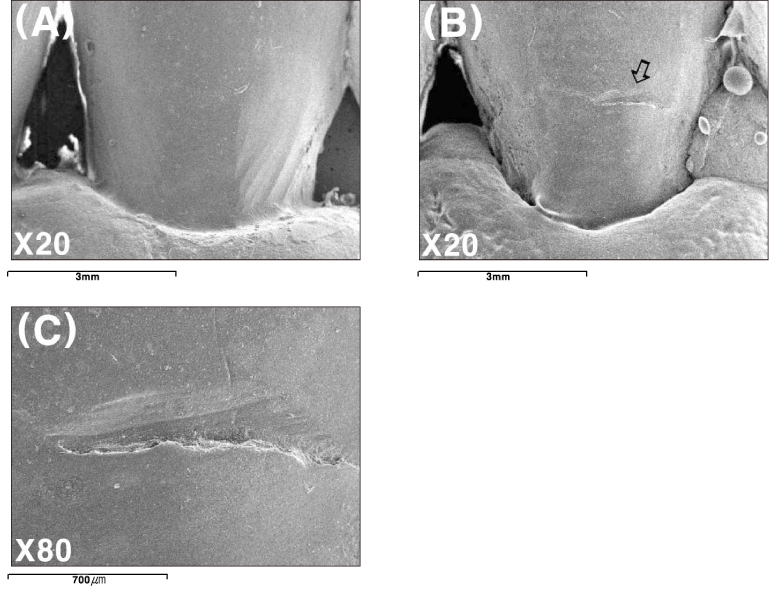J Korean Acad Conserv Dent.
2006 Jul;31(4):300-311. 10.5395/JKACD.2006.31.4.300.
Prospective clinical evaluation of three different bonding systems in class V resin restorations with or without mechanical retention
- Affiliations
-
- 1Department of Conservative Dentistry, School of Dentistry, Seoul National University, Seoul, Korea. chobh@snu.ac.kr
- 2Dental Research Institute, Seoul National University, Seoul, Korea.
- 3Vericom R&D Center, Anyang, Korea.
- KMID: 1986873
- DOI: http://doi.org/10.5395/JKACD.2006.31.4.300
Abstract
- The purpose of this study is to evaluate prospectively the effect of different bonding systems and retention grooves on the clinical performance of resin restorations in non-carious cervical lesions (NCCLs). Thirty-nine healthy adults who had at least 2 NCCLs in their premolar areas were included in this study. One hundred and fifty teeth were equally assigned to six groups: (A) Scotchbond Multi-Purpose (SBMP, 3M ESPE, St. Paul, MN, USA, 4th generation bonding system) without retention grooves; (B) SBMP with retention grooves; (C) BC Plus (Vericom Co., Anyang, Gyeonggido, Korea, 5th generation bonding system) without retention grooves; (D) BC Plus with retention grooves; (E) Adper Prompt (3M ESPE, Seefeld, Germany, 6th generation bonding system) without retention grooves; (F) Adper Prompt with retention grooves. All cavities were filled with a hybrid composite resin, Denfil (Vericom Co., Anyang, Gyeonggido, Korea) by one operator. Restorations were evaluated at baseline and at 6-month recall, according to the modified USPHS (United States Public Health Service) criteria. Additionally, clinical photographs were taken and epoxy resin replicas were made for SEM evaluation. At 6-month recall, there were some differences in the number of alpha ratings among the experimental groups. But, despite the differences in the number of alpha ratings, there was no significant difference among the 3 adhesive systems (p > 0.05). There was also no significant difference between the groups with or without mechanical retention (p > 0.05). Follow-ups for longer periods than 6 months are needed to verify the clinical performance of different bonding systems and retention grooves.
Keyword
MeSH Terms
Figure
Cited by 1 articles
-
Comparison of marginal microleakage between low and high flowable resins in class V cavity
Sang-Bae Bae, Young-Gon Cho, Myeong-Seon Lee
J Korean Acad Conserv Dent. 2009;34(6):477-483. doi: 10.5395/JKACD.2009.34.6.477.
Reference
-
1. Browning WD, Brackett WW, Gilpatrick RO. Retention of microfilled and hybrid resin-based composite in noncarious Class 5 lesions: a double-blind, randomized clinical trial. Oper Dent. 1999. 24:26–30.2. Levitch LC, Bader JD, Shugars DA, Heymann HO. Non-carious cervical lesions. J Dent. 1994. 22:195–207.
Article3. Bader JD, Levitch LC, Shugars DA, Heymann HO, McClure F. How dentists classified and treated non-carious cervical lesions. J Am Dent Assoc. 1993. 124:46–54.
Article4. Mjor IA, Shen C, Eliasson ST, Richter S. Placement and replacement of restorations in general dental practice in Iceland. Oper Dent. 2002. 27:117–123.5. Smales RJ, Webster DA. Restoration deterioration related to later failure. Oper Dent. 1993. 18:130–137.6. Smales RJ, Gerke DC. Clinical evaluation of light-cured anterior resin composites over periods of up to 4 years. Am J Dent. 1992. 5:208–212.7. Hickel R, Manhart J. Longevity of restorations in posterior teeth and reasons for failure. J Adhes Dent. 2001. 3:45–64.8. Summitt JB, Robbins JW, Schwartz RS. Fundamentals of Operative Dentistry: A Contemporary Approach. 2001. ed 2. Illinois: Quintessence Publishing;396.9. Inoue S, Vargas MA, Abe Y, Yoshida Y, Lambrechts P, Vanherle G, Sano H, Van Meerbeek B. Microtensile bond strength of eleven contemporary adhesives to dentin. J Adhes Dent. 2001. 3:237–245.10. Inoue S, Vargas MA, Abe Y, Yoshida Y, Lambrechts P, Vanherle G, Sano H, Van Meerbeek B. Microtensile bond strength of eleven contemporary adhesives to enamel. Am J Dent. 2003. 16:329–334.11. Agostini FG, Kaaden C, Powers JM. Bond strength of self-etching primers to enamel and dentin of primary teeth. Pediatr Dent. 2001. 23:481–486.12. Kanemura N, Sano H, Tagami J. Tensile bond strength to and SEM evaluation of ground and intact enamel surfaces. J Dent. 1999. 27:523–530.
Article13. Tay FR, Pashley DH, Suh BI, Carvalho RM, Itthagarun A. Single-step adhesives are permeable membranes. J Dent. 2002. 30:371–382.
Article14. Borcic J, Anic I, Smojver I, Catic A, Miletic I, Ribaric SP. 3D finite element model and cervical lesion formation in normal occlusion and in malocclusion. J Oral Rehabil. 2005. 32:504–510.
Article15. Tanaka M, Naito T, Yokota M, Kohno M. Finite element analysis of the possible mechanism of cervical lesion formation by occlusal force. J Oral Rehabil. 2003. 30:60–67.
Article16. McCoy RB, Anderson MH, Lepe X, Johnson GH. Clinical success of class V composite resin restorations without mechanical retention. J Am Dent Assoc. 1998. 129:593–599.
Article17. Pashley DH, Sano H, Ciucchi B, Yoshiyama M, Carvalho RM. Adhesion testing of dentin bonding agents: a review. Dent Mater. 1995. 11:117–125.
Article18. Hashimoto M, Ohno H, Kaga M, Endo K, Sano H, Oguchi H. In vivo degradation of resin-dentin bonds in humans over 1 to 3 years. J Dent Res. 2000. 79:1385–1391.
Article19. Wucher M, Grobler SR, Senekal PJ. A 3-year clinical evaluation of a compomer, a composite and a compomer/composite (sandwich) in class II restorations. Am J Dent. 2002. 15:274–278.20. Gordan VV, Mjor IA, Vazquez O, Watson RE, Wilson N. two-year clinical evaluation. J Esthet Restor Dent. 2002. 14:296–302.21. Ryge G, Snyder M. Evaluating the clinical quality of restorations. J Am Dent Assoc. 1973. 87:369–377.
Article22. Pashley EL, Agee KA, Pashley DH, Tay FR. Effects of one versus two applications of an unfilled, all-in-one adhesive on dentine bonding. J Dent. 2002. 30:83–90.
Article23. Uno S, Abo T, Tanaka T, Sano H. In vitro sealing performance of two one-step adhesive systems in cervical cavities. J Adhes Dent. 2004. 6:211–219.24. Yoshida E, Uno S. Voids formation along the bonding interface between a smeared dentin surface and all-in-one adhesives. Dent Mater J. 2004. 23:643–649.
Article25. Tay FR, Pashley DH, Garcia-Godoy F, Yiu CK. Single-step, self-etch adhesives behave as permeable membranes after polymerization. Part II. Silver tracer penetration evidence. Am J Dent. 2004. 17:315–322.26. Perdigao J, Carmo AR, Anauate-Netto C, Amore R, Lewgoy HR, Cordeiro HJ, Dutra-Correa M, Castilhos N. Clinical performance of a self-etching adhesive at 18 months. Am J Dent. 2005. 18:135–140.27. Duke ES, Robbins JW, Snyder DS. Clinical evaluation of a dentinal adhesive system: three-year results. Quintessence Int. 1991. 22:889–895.28. Duke ES, Lindemuth J. Variability of clinical dentin substrates. Am J Dent. 1991. 4:241–246.29. Gwinnett AJ, Kanca J 3rd. Interfacial morphology of resin composite and shiny erosion lesions. Am J Dent. 1992. 5:315–317.30. Tilliss TS, Keating JG. Understanding and managing dentin hypersensitivity. J Dent Hyg. 2002. 76:296–310.
- Full Text Links
- Actions
-
Cited
- CITED
-
- Close
- Share
- Similar articles
-
- Development of anticariogenic composite resin
- The shear bond strength of two adhesives bonded to composite resin and glass ionomer cement restorations
- A 3-year retrospective study of clinical durability of bulk-filled resin composite restorations
- Comparative evaluation of micro-shear bond strength between two different luting methods of resin cement to dentin
- Effect of the additional etching procedure on push-out bond strength of one-step resin cement




